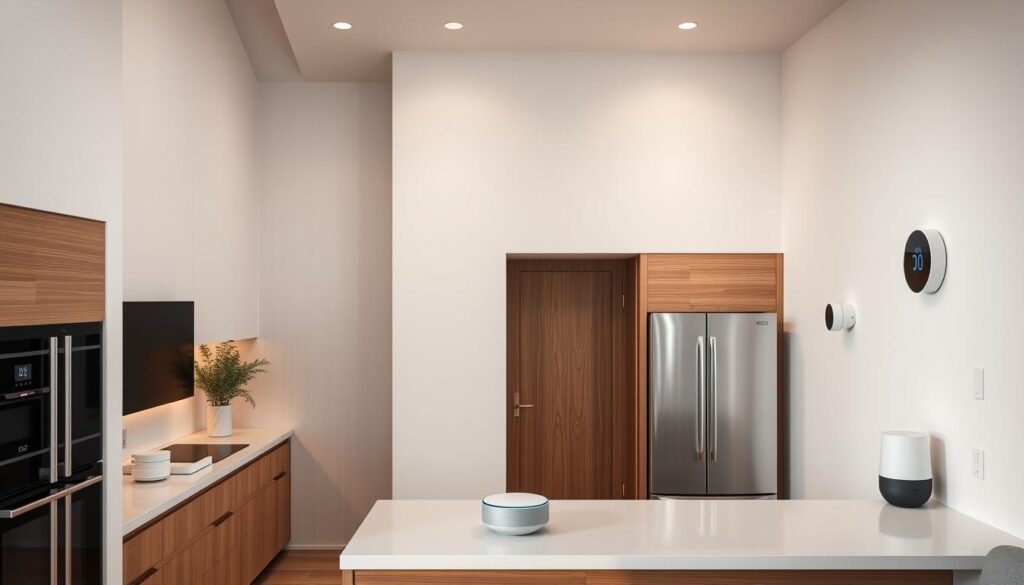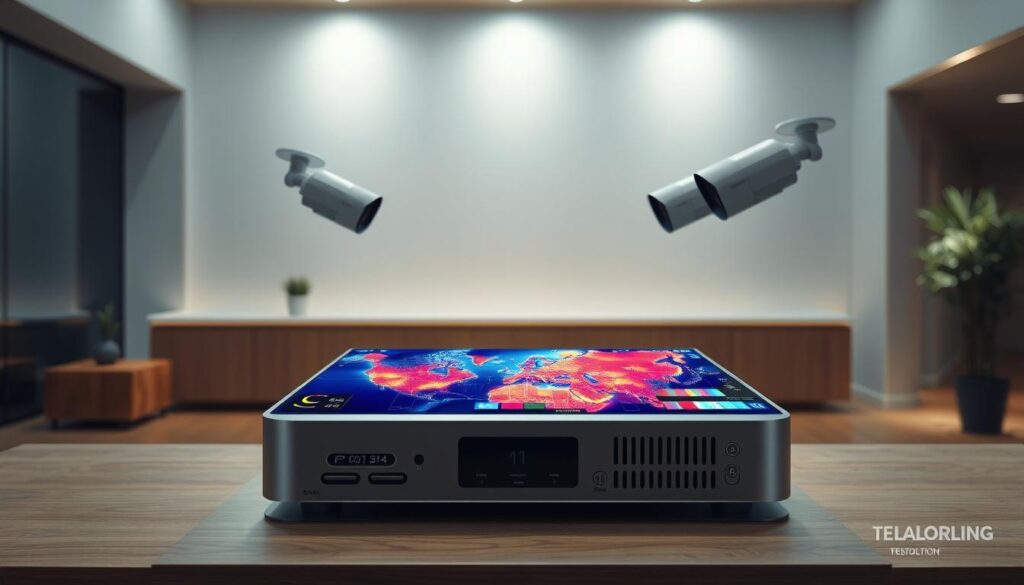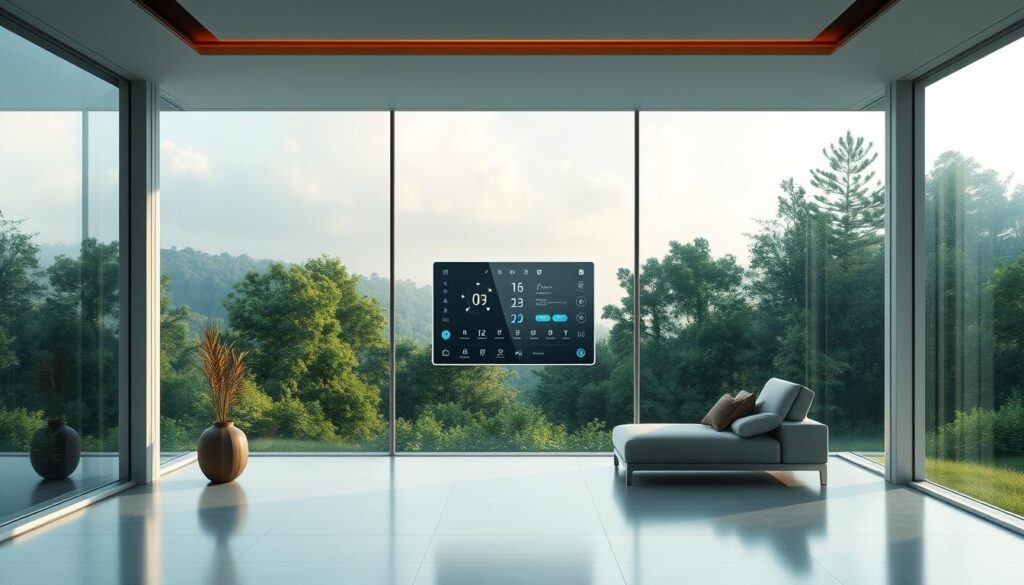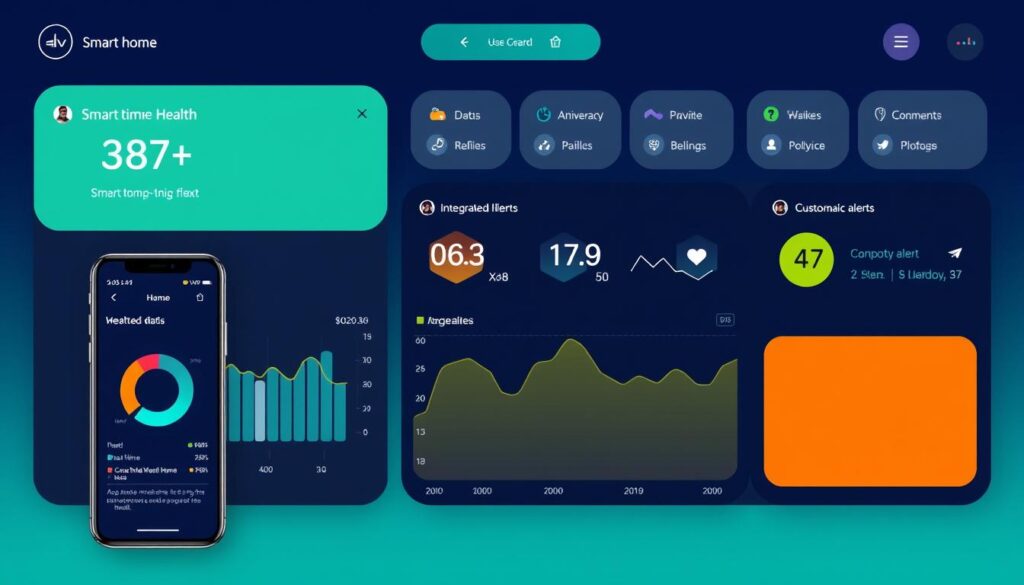Ai smart Home In USA: We’re on the cusp of a revolution in the United States, with AI-powered homes transforming the way we live by 2026.
The latest technological advancements are making homes more intuitive, responsive, and efficient. AI systems are evolving to understand and anticipate homeowners’ needs without explicit commands.
As we integrate various systems in our homes, we’re turning ordinary houses into intelligent living spaces that adapt to occupants’ preferences and behaviors.
The American market is leading global innovation in residential AI technology, and we’re excited to explore what this means for homeowners.
Key Takeaways
- The future of homes in the USA is AI-powered and highly automated.
- Technological advancements are making homes more intuitive and responsive.
- AI systems are becoming more sophisticated in understanding homeowners’ needs.
- The integration of various systems is creating intelligent living spaces.
- The US is at the forefront of global innovation in residential AI technology.
The Evolution of Smart Homes in America
The smart home landscape in America has undergone significant transformations over the years. Traditionally, smart homes relied on explicit input from apps or voice assistants like Alexa. However, the evolution is moving toward homes that are more reactive to our actions and adapt automatically.
We have witnessed a significant shift from manually controlled devices to proactive assistant technologies that anticipate our needs. At the same time, the integration of various systems has created more cohesive smart home experiences.
| Era | Characteristics |
|---|---|
| Early Adoption | Basic automated devices, novelty gadgets |
| Current State | AI-driven systems, essential household infrastructure |
| Future | Proactive assistant technologies, anticipatory homes |
As we move forward in time, we can expect even more sophisticated AI implementations in American smart homes. 
Current State of AI Smart Home In USA
The United States is witnessing a substantial growth in AI smart home adoption, driven by innovative devices and services. As we examine the current landscape, it’s evident that various systems are being integrated into American homes.
Current systems can localize humans by measuring reflections of wireless signals off their bodies, but they can’t always identify individuals. Other systems can identify people, but only if they’re carrying mobile devices. This highlights a significant limitation in today’s implementations.
We’re seeing a varied penetration rate of smart home devices across different American households. Some technologies have gained more traction than others, and we’re analyzing how these devices are serving American residents.
The adoption of AI smart home technology varies across different states and demographic groups. We’re also exploring the most popular services and features that consumers are currently using in their AI-enabled homes.

Despite the advancements, current systems face challenges in truly understanding and responding to human behavior. Different manufacturers are positioning themselves in the competitive American smart home market, offering a range of services and devices.
Key Technologies Driving the Smart Home Revolution
The smart home revolution is being fueled by advancements in various technologies that are changing how our homes understand and respond to us. As we explore these innovations, it becomes clear that the future of smart homes is not just about automation, but about creating a more intuitive and responsive living environment.
AI Vision Inside Technology
AI Vision Inside technology is a significant advancement, enabling systems to recognize and label various household items. For instance, it can identify 37 unobscured fresh food items such as select fruits and vegetables. This capability is crucial for developing a system that can understand the home environment and occupant activities by processing images.

Advanced Voice Recognition Systems
Advanced voice recognition is another key technology, evolving from simple command processing to understanding context, tone, and even emotional states. This is achieved through sophisticated machine learning models that are trained to recognize patterns in household behavior, thereby enhancing the overall smart home experience.
These technologies, among others, are working together to create a more personalized and efficient living space. As they become more affordable and accessible, we can expect to see widespread adoption in homes across the country.
Occupant-Aware Homes: The Next Frontier
The future of smart homes lies in their ability to recognize and adapt to individual occupants. As we explore this next frontier, we’re looking at how homes can automatically adjust to our preferences, making our living spaces more comfortable and efficient.
Automatic Preference Adaptation
Imagine walking into a room and having the system adjust to your preferred temperature automatically. This is made possible through advanced sensors and AI algorithms that learn and adapt to individual preferences over time.
Movement Tracking and Identification
Precise location tracking throughout the home is crucial for occupant-aware systems. By using a combination of sensors and AI, these systems can identify individuals and adjust settings accordingly, optimizing power usage based on who is present and their preferences.
| Feature | Benefit | Technology |
|---|---|---|
| Automatic Temperature Adjustment | Enhanced Comfort | Advanced Sensors and AI |
| Personalized Lighting | Energy Efficiency | Smart Lighting Systems |
| Intelligent Entertainment | Customized Experience | AI-powered Media Systems |

MIT’s Duet System: Revolutionizing Occupant Recognition

Occupant recognition is being revolutionized by MIT’s innovative Duet System. This cutting-edge technology identifies individuals within a smart home even when they’re not carrying their mobile devices. By utilizing reflected wireless signals, Duet localizes individuals and incorporates algorithms that predict identities.
How Duet Works Without Mobile Devices
Duet’s functionality is based on its ability to use wireless signals to track occupants. It doesn’t solely rely on a person’s phone to identify them, making it a robust system for various smart home applications.
Accuracy and Implementation Challenges
While Duet has shown remarkable accuracy in identifying individuals, with experiments demonstrating 96 percent and 94 percent accuracy, implementing this system in real-world home environments poses challenges. These include maintaining location awareness and overcoming signal-denied areas.
As we explore the potential of Duet, it’s clear that this technology could significantly impact the future of smart homes, enhancing both convenience and security without relying on a user’s phone proximity.
AI-Powered Kitchen Innovations for 2026

AI is transforming the kitchen experience with cutting-edge technologies expected by 2026. We’re seeing significant advancements in smart kitchen appliances that are changing how we cook and interact with our kitchen.
Smart Refrigerators with Food Recognition
Smart refrigerators equipped with AI Vision Inside technology can recognize and automatically label 37 unobscured fresh food items, such as select fruits and vegetables. This intelligent system helps in inventory management and suggests recipes based on available items.
Automated Cooking Assistants
Automated cooking assistants are evolving beyond simple timers. They now guide the cooking process with adaptive instructions, making cooking easier and more personalized. These innovative kitchen products are becoming integral to the cooking experience.
As AI continues to integrate into the kitchen, we’re likely to see a more cohesive cooking ecosystem that reduces food waste and personalizes meal preparation.
Energy Efficiency Through Artificial Intelligence
As we move towards a more sustainable future, AI is playing a crucial role in optimizing energy efficiency in smart homes. The use of AI in managing home energy consumption is becoming increasingly sophisticated, allowing homeowners to reduce their energy usage without sacrificing comfort.
AI Energy Mode Optimization
AI Energy Mode Optimization is a cutting-edge feature that adjusts the compressor speed and defrost cycle of appliances based on usage patterns and conditions. By optimizing these processes, AI significantly reduces energy waste, leading to more efficient operation. For instance, AI can analyze data on household occupancy and adjust the temperature accordingly, ensuring that energy is not wasted on heating or cooling an empty home.
Predictive Power Management
Predictive Power Management takes energy efficiency a step further by anticipating the power needs of a household. Using advanced algorithms, this system can forecast energy demand based on historical data and external factors like weather forecasts. By doing so, it optimizes power consumption, reducing the strain on the grid during peak hours and lowering energy bills for homeowners.
| Feature | Description | Benefit |
|---|---|---|
| AI Energy Mode | Optimizes compressor speed and defrost cycle | Reduced energy waste |
| Predictive Power Management | Anticipates power needs based on historical data and weather | Lower energy bills and reduced grid strain |
Personalized Living Spaces: Beyond Basic Automation
With AI at the helm, our living spaces are transforming into highly personalized environments. This transformation is driven by advanced algorithms that learn our preferences and adapt our home accordingly.
Behavioral Learning Algorithms
Our homes are becoming increasingly adept at understanding our daily routines through behavioral learning algorithms. These analyze patterns in our activities and adjust the home environment to suit our needs based on the time of day.
Mood and Activity-Based Adjustments
The system will also make adjustments based on our moods and activities throughout the day. For instance, lighting and sound settings can be altered to create a more conducive environment for relaxation or productivity.
| Time of Day/Activity | Lighting | Sound | Climate |
|---|---|---|---|
| Morning Routine | Bright | Upbeat Music | Warm |
| Relaxation Time | Dim | Calming Sounds | Cool |
| Workout | Bright | Energetic Music | Cool |
Health Monitoring and Wellness Applications
As AI technology advances, smart homes are becoming increasingly sophisticated in their ability to monitor and support the health and wellness of their occupants. AI smart home health monitoring systems are designed to capture valuable insights that can be used for healthcare applications.

Behavioral Analytics for Healthcare
Behavioral analytics play a crucial role in healthcare applications within AI smart homes. By tracking subtle changes in daily routines, these systems can identify potential health concerns early on. For instance, changes in movement patterns or activity levels can be indicative of conditions such as depression or cognitive decline.
Early Detection of Health Issues
The ability of AI systems to detect patterns over time is particularly valuable for the early detection of health issues. By continuously monitoring occupant behavior throughout the day, these systems can provide healthcare providers with valuable information for monitoring and treatment. This can be especially beneficial for elder care and independent living for seniors.
Privacy and Security Considerations
With the growing adoption of AI smart home technologies, it’s essential to address the pressing issues of privacy and security. As our homes become increasingly connected and intelligent, the potential risks associated with data collection and usage come to the forefront.
Data Protection Measures
Manufacturers are implementing robust data protection measures to safeguard sensitive household information. This includes encryption technologies and secure data storage solutions. The table below highlights some key data protection measures being adopted:
| Measure | Description | Benefit |
|---|---|---|
| End-to-End Encryption | Encrypts data from device to server | Protects against unauthorized access |
| Secure Authentication | Multi-factor authentication for users | Reduces risk of unauthorized access |
| Regular Software Updates | Ensures devices stay secure with latest patches | Fixes vulnerabilities, enhances security |
User Consent and Control
The researchers envision that their system would be used with explicit consent from anyone who would be identified and tracked. If needed, they could also develop an app for users to grant or revoke access to their location information at any time. This approach ensures that users have granular control over their data, striking a balance between convenience and privacy.
Integration with Mobile and Wearable Devices
The integration of AI smart homes with mobile and wearable technology is revolutionizing how we interact with our living spaces. Smartphones serve as both controllers and identification tokens in the AI home ecosystem. With our phone, we can control various devices and adjust settings through a dedicated app, enhancing the overall living experience.
devices and our mobile phone, AI systems can optimize power usage and create a more personalized environment.
Market Projections for AI Smart Homes by 2026
Looking ahead to 2026, we can anticipate several key developments in the AI smart home sector. The market is expected to grow significantly, driven by advancements in AI technology and increasing consumer demand for smart home products.
We’ll examine expected growth rates across different product categories and price points, as well as how subscription-based services are likely to shape the economic model of smart home offerings. Regional variations in adoption rates and preferences across the American market will also be explored.
- Analyzing market trends and projections for AI smart home adoption in the United States through 2026.
- Discussing the impact of subscription-based services on the industry.
- Addressing key questions about market saturation and technological obsolescence.
Key players in the industry will likely see shifts in market share as emerging companies introduce innovative products and services. Consumer spending patterns will be crucial in determining the direction of the market.
Preparing Your Home for the AI Revolution
With AI technology advancing rapidly, it’s essential to get your home ready for the smart future. To prepare, consider your home’s infrastructure, including networking and power requirements, to support new devices and systems. Evaluate which kitchen and energy systems will add the most value. Implementing smart home technology can be done in phases to avoid overwhelming budgets. Ensure you prioritize privacy and security best practices to protect your family’s information. By doing so, you’ll be well on your way to a seamless AI-integrated home experience.




















